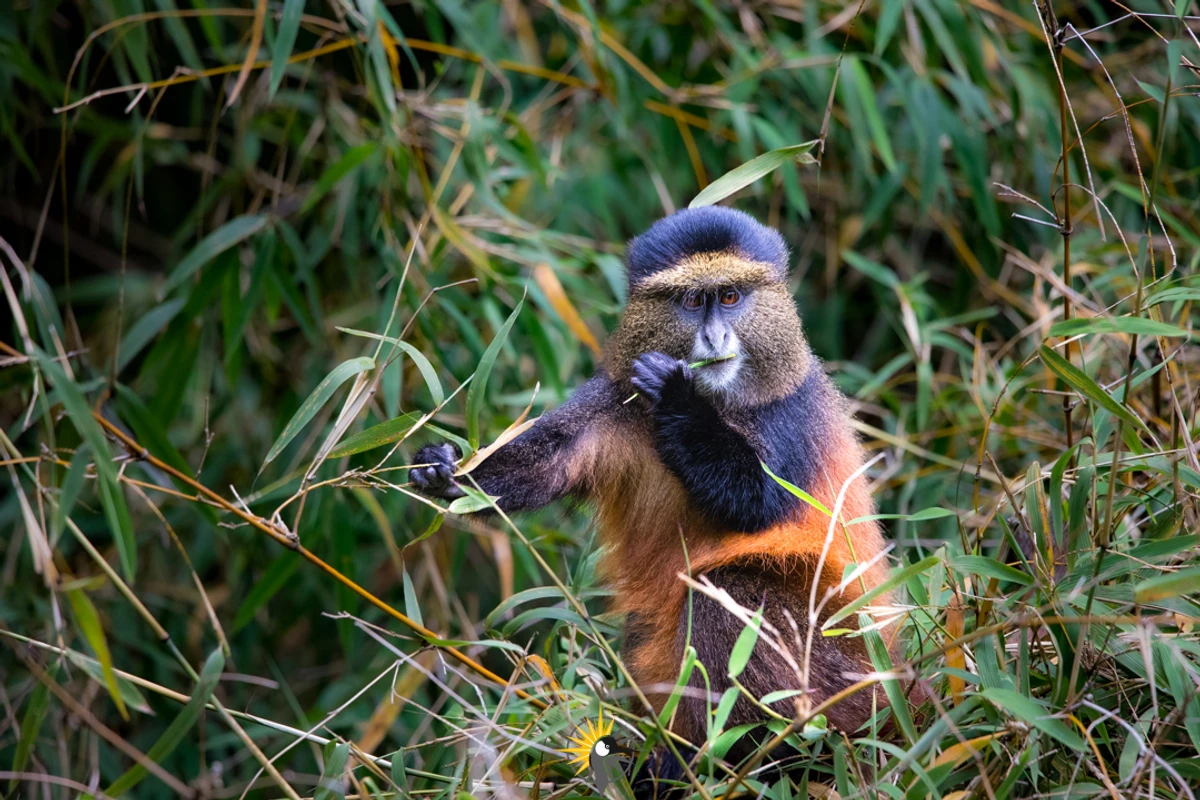The Golden monkey (Cercopithecus kandti) is among the most captivating creatures in East Africa's montane forests. Its striking appearance, unique behavior, and endangered status makes it a focus of conservation efforts and a highlight for wildlife enthusiasts. In this article, we delve into the details of the golden monkey , exploring its habitats, diet, behavior, conservation, and opportunities for ecotourism.
Understanding The Golden Monkey
The Golden monkey is a sub specie of the blue monkey (Cercopithecus mitis), easily recognized by its vibrant golden-orange fur that contrasts beautifully with their black limbs, tail, and face. Its distinct coloration varies slightly depending on their environment, but they always stand out due to their striking appearance.
This primate is medium-sized, with adults typically weighing between 4 to 7 kilograms (8.8 to 15.4 pounds) and measuring about 50 to 70 centimeters (20 to 28 inches) in body length. Its tail is nearly as long as Its body, helping it maintain balance as it leaps and climbs through bamboo forests.
Where the Golden Monkey calls home
The Golden monkey are endemic to the Albertine Rift in East Africa, thriving in high-altitude montane forests. It relies heavily on the bamboo thickets that dominate these environments, with its habitats concentrated in three main areas.
Volcanoes National Park in Rwanda
This renowned park is home to one of the largest populations of golden monkeys. The lush bamboo forests provide a haven for these primates, and the park's conservation programs ensure their protection. Volcanoes National Park is also a major hub for ecotourism, drawing visitors from around the globe to experience golden monkey trekking.
Mgahinga Gorilla National Park in Uganda
In Uganda, Mgahinga Gorilla National Park offers a critical habitat for golden monkeys. The park’s bamboo forests are ideal for these primates, and the smaller number of visitors compared to Rwanda creates a more intimate trekking experience. Mgahinga is part of the Virunga massif, a crucial area for golden monkey conservation.
Virunga National Park in the Democratic Republic of Congo
The golden monkeys also inhabit Virunga National Park, Africa’s oldest national park. While the park is a vital part of their range, conservation efforts in this region face challenges due to political instability, which limits both protection and tourism activities.
What the Golden monkey eats and how it adapts
The Golden monkey is primarily herbivorous, with a strong preference for bamboo, which forms the foundation of their diet. Its eating habits are closely tied to the seasons and the availability of food within their habitat.
Bamboo as the primary food source
Bamboo shoots are their favorite food, especially during the rainy season when they are abundant and nutritious. When bamboo shoots are scarce, golden monkeys adapt by eating bamboo leaves and stems.
Seasonal dietary variations
During drier periods, golden monkeys supplement their diet with fruits, flowers, and leaves from other plants. Occasionally, they consume small insects to add protein to their meals. This dietary flexibility allows them to survive in their relatively specialized habitat.
The social lives of Golden monkeys
Golden monkeys are highly social animals, living in groups that range in size from 20 to over 100 individuals. These groups are led by a dominant male, who plays a vital role in protecting the troop and guiding their movements through the forest.
Bonding through grooming
Grooming is an essential activity among golden monkeys, strengthening social bonds and reducing stress. It also helps maintain hygiene by removing dirt and parasites. This behavior is most commonly observed during periods of rest.
Communication and interaction
Golden monkeys are vocal creatures, using a variety of sounds to communicate within their groups. These calls convey important information, such as warnings about predators, mating signals, or calls for group cohesion. In addition to vocalizations, they use body language and facial expressions to express emotions and maintain social harmony.
Daily life and behavior patterns
Golden monkeys are diurnal, meaning they are active during the day. Their activities revolve around three main tasks: foraging, resting, and socializing.
Foraging in the morning
Mornings are typically spent searching for food, with the troop moving through the forest to locate fresh bamboo or other available vegetation. Their agility allows them to cover large areas quickly, often leaping between bamboo stalks with remarkable precision.
Afternoon relaxation and play
After their morning foraging, golden monkeys spend afternoons resting and engaging in social activities. Younger monkeys are particularly playful, chasing each other through the trees and engaging in mock fights.
Threats and conservation of golden monkeys
Golden monkeys face several threats that put their survival at risk. Despite their adaptability, their reliance on specific habitats makes them particularly vulnerable to environmental changes and human activities.
Habitat loss as a major threat
Deforestation for agriculture, logging, and human settlement has led to significant habitat loss for golden monkeys. The destruction of bamboo forests reduces their food supply and forces them into smaller, fragmented ranges, increasing competition for resources.
The role of conservation programs
National parks like Volcanoes National Park and Mgahinga Gorilla National Park have become vital in protecting golden monkeys. Conservation programs in these areas focus on habitat preservation, anti-poaching measures, and community involvement. Ecotourism, particularly golden monkey trekking, generates revenue that supports these efforts and provides economic benefits to local communities.
The Golden monkey trekking experience
Golden monkey trekking is a unique and rewarding wildlife experience, offering visitors the chance to observe these rare primates in their natural habitat.
What to expect during a trek
Treks usually begin with a briefing by park rangers, who provide information about the monkeys and the trekking rules. Visitors then embark on a guided hike through bamboo forests to locate a habituated group of golden monkeys. These groups are accustomed to human presence, allowing for close observation.
Best times and conditions for trekking
Golden monkey trekking is available year-round, but the dry seasons from June to September and December to February are ideal. During these months, trails are easier to navigate, and visibility in the forests is improved.
Trekking guidelines and ethics
To ensure minimal disturbance to the monkeys and their environment, trekkers must adhere to strict guidelines. These include maintaining a safe distance, avoiding loud noises, and following the instructions of the guide at all times. Respecting these rules not only protects the monkeys but also enhances the experience for all visitors.
Golden monkeys in the ecosystem
Golden monkeys play a crucial role in maintaining the health of their ecosystem. As seed dispersers, they contribute to forest regeneration by spreading seeds from the fruits they eat. Their presence also supports the tourism industry, which brings economic benefits to local communities and funds for conservation initiatives.
Why Golden monkeys deserve our attention
Golden monkeys are a symbol of East Africa’s rich biodiversity and a testament to the importance of conservation. Protecting these primates ensures the preservation of their unique ecosystem and highlights the delicate balance between wildlife and human development.
For visitors, the opportunity to see golden monkeys in the wild is both a privilege and a reminder of the responsibility we have to protect the planet's incredible biodiversity. Through sustainable tourism, community engagement, and ongoing conservation efforts, we can ensure that these enchanting primates continue to thrive for generations to come.









